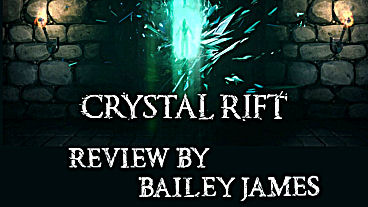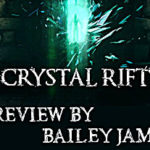
Crystal Rift Review
Every laugh or moment of enjoyment this game wrung out of me was unintentional.







Genre: Adventure
Release date: March 30, 2016
Crystal Rift, developed by Psytec Games, is the product of a gaming culture so obsessed with new technological developments that it is willing to disregard all the elements that make a good game in service of cutting-edge platforms. Created for virtual reality headsets like the Oculus Rift and funded by a Kickstarter, the game is a loveless marriage between “retro” graphics (aka “hasn’t been impressive since Doom was released”) and a limp, outmoded play style that combine to make something so unfun it feels outlandish to call it a game.
Disclaimer: I played Crystal Rift without a virtual reality headset on my PC, so I readily concede that my opinions of the gameplay are not fully informed as to the capabilities a device such as Oculus Rift would provide. However, I’m confident in my opinion that such a device wouldn’t make this title any less tedious and boring.
There isn’t one. After playing for an hour I could sense the vague suggestion of a plot via a series of notes left lying around the game world, but nothing concrete. Some mysterious dark force that needed containing, or slaying, or mastering? All was made less clear by the fact that just as many scattered notes were cutesy gamer jokes that only confused what was already going on (“ATTENTION!!! Prisoner tests are voluntary. Any prisoner unwilling to partake will be beaten. Beatings are mandatory.”) Were the weaponized skeletons beings from another dimension that came through a “crystal rift,” or were they the prisoners contained in the dungeons reincarnated to seek their revenge? A braver, more patient soul than I will have to answer that question.
Your character is a male grunt (no, not a henchman—I mean that the only thing you know about him is that he makes masculine groans when he dies). Hopefully we can look forward to a time in the future where the personality-free main character’s grunts are female, but that day is not today. Our nameless protagonist swings a sword and shuffles forward through the dungeons, pulled deeper into the warren by—what? What is his personal stake in all this? We’ll never know.
Crystal Rift has all the visual complexity of the Windows 98 Maze screensaver with half the entertainment value (at least THAT labyrinth could flip upside down to surprise you every once in awhile). Its flat graphics are probably inspired by the low-res aesthetic of Minecraft, but whereas that game created a unique visual identity all its own, Crystal Rift feels like it’s just recycling the bland visual style of much older games for nostalgia value. It’s not inherently delightful to revisit a time when everyone and everything could only move at right angles, and there’s nothing novel presented here to challenge the fact that we should be happy to have left this era of gaming behind. Are we really still presenting a skeleton wielding a sword and wearing knockoff Ugg boots as something intimidating?
To make matters even more tangled, the game bills itself partly as a horror title. You can adjust the level of “scares,” which basically amount to a randomly generated handful of surprise appearances by shadowy spooks in windows and air shafts. On a personal level I don’t believe procedurally-generated horror is effective in any game as fear is contextual, based on the buildup of suspense and mood, and being startled isn’t the same as feeling afraid. The fact that you can completely turn off the scares without in any way changing the form of the gameplay experience is a testament to how nonessential it is.
Even moments that could have been suspenseful (such as a pathway where a large boulder rolls toward you) are ruined by the fact that the game triggers these hazards automatically instead of letting the player approach them unawares before encountering the trap. Even worse are the mine cart sections, which involve the player rolling slowly unprotected through the environment. But there are no controls, no way to steer the mine cart or use your weapon or climb out, so there’s obviously nothing that can actually harm your character while it’s in these sequences. The result of all this is something masquerading as dangerous while utterly failing to be so, like a kitten wearing a Dracula costume.
I might not have gotten fed up with this game so quickly if its controls and gameplay weren’t such a mystery from the beginning. Nowhere does Crystal Rift explain the full range of key commands and movements available, so since I wasn’t using an intuitive VR headset, I had to use trial-and-error to figure out how to rotate the camera, how to equip my sword, and how to change whether it could be used as a boomerang or shoot streams of poison. (Really? You think my mouse’s scroll wheel is a self-evident command?) These headaches are the kind of “puzzles” the player doesn’t want to be solving because they get in the way of the fun.
The actual puzzles aren’t much better, though. Flip switches to open doors or activate trapdoors, find keys or crystals to open clearly labeled entrances. None of it taxed or surprised me — the puzzles are tedious and the occasional combat situations with a rhymeless mix of enemies from rock golems to sentient geometric shapes are one-note and irritating.
Besides the basic puzzles necessary to move the plot forward, there are several decorative skulls hidden throughout the game, and there was occasional fun in discovering the chink in a seemingly solid wall that hid a treasure behind it. But the skulls don’t enhance or clarify the story, and some research revealed that the only reward for collecting them is to unlock more of the game. That’s a cruel punishment if I’ve ever heard one.
Every laugh or moment of enjoyment this game wrung out of me was unintentional. The goofy slime monsters carting around a belly of skulls and making goonish faces; the fact that every note could be unnecessarily spun and rotated around; the melodramatic quotes paired with the hidden decorative skulls are all the unintentional effects of a game that seems to waffle between taking itself too seriously and not seriously enough.
I think that a lot of the game’s problems stem from the fact that the developers wanted to include a level editor, which meant that every element of the game had to be standardized and, thus, made boring. Being able to create your own jumble of generic interlocking pieces isn’t interesting, and the game would have been better off sticking to either a build-your-own VR puzzle editor or a well-developed story mode. Crystal Rift isn’t the first game that has used the promise of Virtual Reality as its primary selling point, and it won’t be the last. But the trick of such an immersive experience is to create a world players want to lose themselves in. When I was done playing this game, the only thing I felt was relief that it was over.
|
+ Some (unintended) funny parts
– Indiscernible plot
– No character development (or character)
– Bland visuals
– Arbitrary horror elements
– No explanation of game controls
– Insultingly easy puzzles |

|
Processor: Dual Core 2.33 GHz Intel or 3.0 GHz AMD
Memory: 2 GB RAM
Graphics: Geforce GTX 8800, AMD Radeon 4850 or Intel HD Graphics 5200 or better (1GB graphics memory or more. Shader Model 3.0 needs to be supported). Minimum supported resolutions 1280×720 and 1024×768.
Hard Drive: 5 GB available space
Processor: Intel Core 2 Duo
Memory: 2 GB RAM
Graphics: Graphics card supporting OpenGL 2.1 or later. (256MB graphics memory or more) Minimum supported resolutions 1280×720 and 1024×768

Leave a Reply